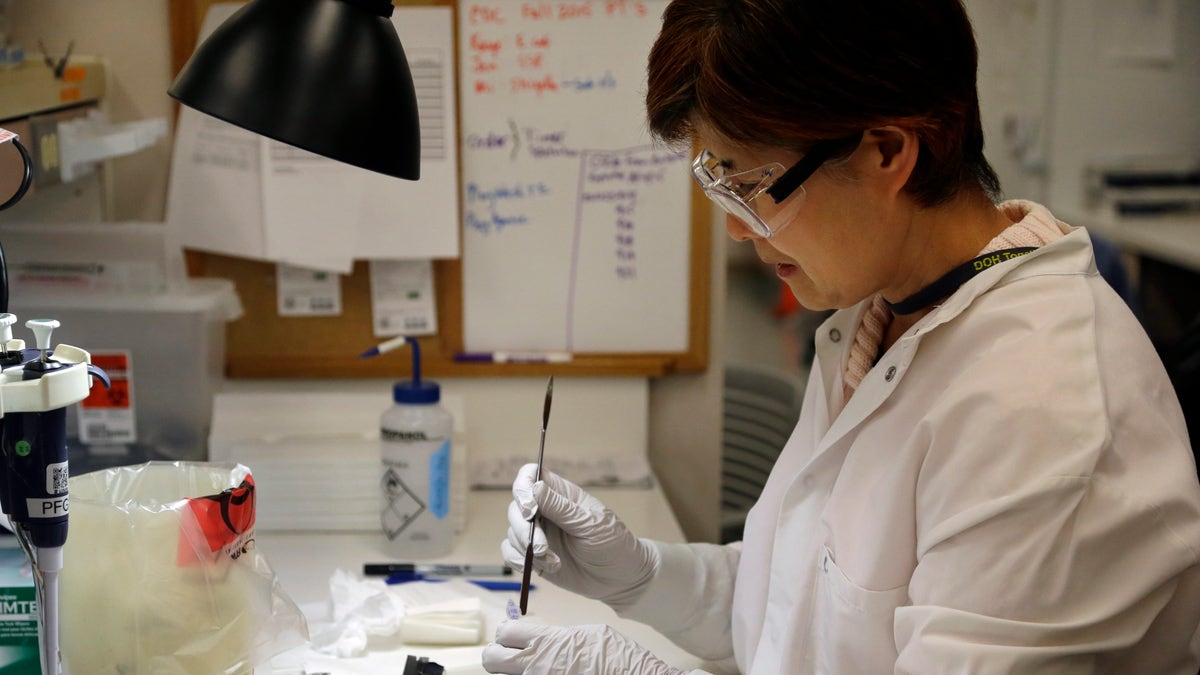
Microbiologist Mi Kang works to identify a strain of E. coli from a specimen in a lab at the Washington State Dept. of Health Tuesday, Nov. 3, 2015, in Shoreline, Wash. (AP Photo/Elaine Thompson)
Thirty-nine people in Washington and Oregon have fallen ill with E. coli in an outbreak connected to Chipotle Mexican restaurants. A total of 14 ill people have been hospitalized, as of Wednesday, according to the Centers for Disease Control and Prevention.
The popular chain of casual restaurants voluntarily closed 43 of its Washington and Oregon locations last week and health officials are scrambling to find the food source of the bacteria.
Here are some things to know about the outbreak:
----
WHAT'S BEING DONE TO FIND THE SOURCE?
Health officials have identified the specific microorganism responsible for the outbreak, Shiga toxin-producing E. coli O26. They are interviewing everyone in both states who has tested positive for that strain of E. coli and are also testing food products from Chipotle restaurants to look for the same bacteria.
With help from the Food and Drug Administration and the Centers for Disease Control and Prevention, the next step will be to get that identification down to the DNA level and then using that information to match people and food.
Health officials believe the bacteria will be found on fresh produce such as lettuce, tomatoes, cilantro or onions, or possibly even spices.
----
HOW IS TECHNOLOGY HELPING IN THE SEARCH?
Chipotle uses technology to track its food supply, from the ground to their restaurants.
The company uses traceability software, made by the Durham, North Carolina-based FoodLogiQ company. It says it can trace every box of fresh ingredients from farm to table, in real time.
This is a big improvement from the information available during past outbreaks.
In 2008, health officials initially suspected raw tomatoes to be the source of a salmonella outbreak that sickened people around the country. Without adequate ways of tracing tomatoes or other contaminated produce to their origins, everybody stopped buying tomatoes, everywhere.
In this case, Chipotle has been able to have a much more targeted response. Health officials are hopeful, but not certain, that the spread of the outbreak was halted when they closed the restaurants in Washington and the Portland, Oregon, area.
----
WHEN WILL CHIPOTLE REOPEN?
While the company is scrubbing down its restaurants in the Northwest, doing its own testing of the supply chain and buying new food, they won't reopen until health officials agree it's safe.
Authorities in Washington and Oregon say they will want to know where the E. coli came from before the restaurants reopen. They say they may have more information as soon as Wednesday but it's likely the full investigation will take more than a few days.
It's also possible more stores will close in Oregon or other nearby states if the investigation finds E. coli cases beyond the current presumed limits of the outbreak. Health officials say they are looking back at a month of public health reports for other possible cases and looking statewide in both Oregon and Washington.
----
WHAT IS E. COLI AND HOW DOES IT GET IN FOOD?
There are hundreds of E. coli and similar bacteria strains in the intestines of humans. Most are harmless, but a few can cause serious problems.
Symptoms of E. coli infection include diarrhea, abdominal cramps, nausea and vomiting.
The bacteria are associated with animal waste, but aren't just associated with meat. E. coli can be spread in indirect ways, such as through water or improperly cured compost.
Even if health officials decide onions are the culprit, for example, that doesn't mean the onion farm is to blame. The E. coli could have been transferred to food transported in a dirty truck or by cross-contamination in a warehouse.
----
SHOULD I STILL WORRY ABOUT GETTING E. COLI?
If you ate at Chipotle in Washington or Oregon last week, you may not be out of the woods yet.
Health officials say the incubation period is 3 to 7 days from the time of exposure. You may also have had some mild symptoms that you didn't recognize as being E. coli.
If you ate at Chipotle any time during the past few weeks and experienced intestinal symptoms, health officials want you to go to the doctor and get tested.
Reuters contributed to this report.